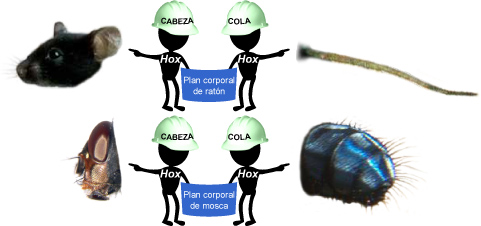Los genes reguladores «de aplicación universal» son elementos importantes para la construcción de organismos complejos como las moscas. Algunos genes reguladores son comunes a muchos organismos (son homólogos — heredados de nuestro antepasado común). Por ejemplo, los genes Hox colaboran en el trazado de la forma corporal básica de muchos animales, incluidos los seres humanos, las moscas y los gusanos, estableciendo la organización cabeza-cola. Puedes pensar en ellos dando instrucciones mientras el embrión se desarrolla: «ipon la cabeza aquí!, ilas piernas van allí!»

Son de aplicación universal en el sentido de que son muy parecidos en muchos organismos: no importa si se está construyendo la cabeza de un ratón o la cabeza una mosca, el proceso lo dirige el mismo gen. Pequeños cambios en estos genes reguladores tan poderosos, o cambios en los genes que activan, podrían constituir una fuente importante de cambio evolutivo.
Learn more about evolution and development in context: Why the eye?, a case study.
Teach your students about development:
Find additional lessons, activities, videos, and articles that focus on development.
Original translation by the Spanish Society of Evolutionary Biology; translation editing by Maya deVries.
